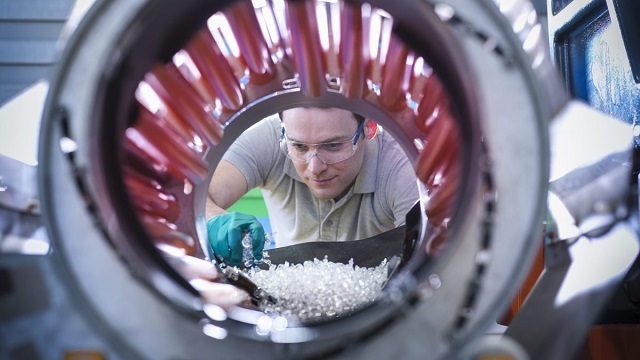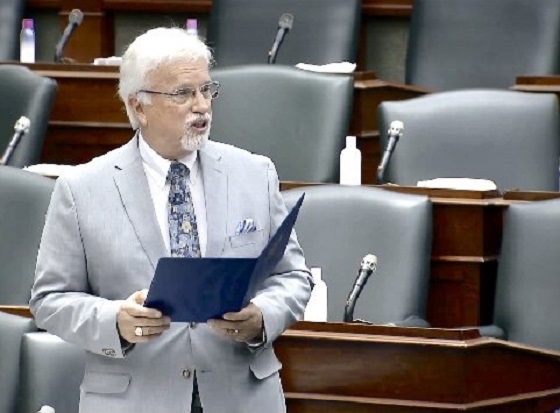Alberta
How natural gas supports one of Canada’s largest manufacturing sectors

Worker inspecting parts from plastic injection moulding machine in plastics factory. Getty Images photo
From the Canadian Energy Centre
‘When you think about the demand for more sustainable outcomes: clean air, clean water, clean energy, safe, nutritious, abundant food and electric vehicles, that’s more and more and more chemistry’
Canada’s chemical industry sold a record $72.7 billion of product last year amid recovery from COVID-19 and strong consumer demand, according to the Chemistry Industry Association of Canada (CIAC).
Natural gas is a key input to the chemistry sector, the broad term that refers to manufacturing a myriad of products used in everyday items from plastics to agriculture and pharmaceuticals.
“Chemistry products go into 95 per cent of finished goods. It’s an important sector,” says CIAC president Bob Masterson.
“It’s a sector that can grow as long as we fancy improving our lives and building a better world for tomorrow.”
Chemicals in Canada
Canada’s chemistry industry is the country’s fourth largest manufacturing sector by value of sales after food ($147 billion), transportation equipment ($119 billion), and petroleum/coal products ($118 billion).
It is primarily centered in Ontario, Alberta and Quebec.
The CIAC publishes an annual report on the sector’s activity using Statistics Canada data, separated into two categories: chemicals overall, and industrial chemicals.
Chemicals overall includes manufacturing of soaps, cleaning compounds, paints, coatings and adhesives, pesticides and fertilizers, pharmaceuticals, rubbers and synthetic fibres, and basic chemicals.
Industrial chemicals refers to the manufacturing of intermediate products used as inputs by industries including plastic and rubber products, forest products, transportation equipment, clothing, perfume and cosmetics, construction and pharmaceuticals.
Global Growth
According to Vantage Market Research, the global chemical market was valued at US$584 billion in 2022. It’s expected to grow by more than 55 per cent in the coming years to reach US$917 billion by 2030.
This isn’t just driven population growth, Masterson says.
“When you think about the demand for more sustainable outcomes: clean air, clean water, clean energy, safe, nutritious, abundant food and electric vehicles, that’s more and more and more chemistry,” he says.
“Some of the predictions are that the volumes of chemistry will double in the next 20 years. Canada and Alberta in particular are exceptionally well positioned to help meet future market demand for these products. The demand is not going away. There’s no question about that.”
Jobs
In 2022, Canada’s chemicals sector directly employed 90,800 people, or approximately the population size of Sudbury, Ontario. The industry paid about $7 billion in salary and wages.
That’s the direct impact of employment in the chemistry sector, but the CIAC estimates the full benefit to Canadians to be much higher as a result of indirect economic activity it supports.
CIAC estimates that every job in Canada’s chemistry sector creates another five indirect jobs in other parts of the economy. This means the sector supported 454,000 jobs across Canada in 2022.
Industrial chemicals alone directly employed 17,100 people and indirectly supported 85,600 jobs in the broader Canadian economy last year, the CIAC says.
Rising Trade
At a value of $72.7 billion, Canada’s overall chemical industry sales were their highest ever in 2022 – a 30 per cent increase compared to 2019, prior to the COVID-19 pandemic.
Industrial chemicals sales reached a record $34.2 billion, a 32 per cent increase compared to 2019.
Exports also increased last year, rising to a value of $52.8 billion compared to $45.9 billion in 2021. Of that, the sector exported $24.8 billion of industrial chemicals, up from $22.5 billion the previous year.
The United States is Canada’s main customer for chemical exports, representing 76 per cent of exports or $40.1 billion in 2022. The next largest export markets are China ($1.86 billion), the Netherlands ($1.7 billion), and the United Kingdom ($1.1 billion).
The Canada Advantage
Canada has distinct advantages as a chemical manufacturer and exporter including growing access to global markets, CIAC says.
In Alberta, the main advantage is access to low-cost natural gas resources – specifically valuable natural gas liquids like ethane, propane and butane.
“The rich abundance of natural gas liquids that come out of the ground when we drill for natural gas let Alberta be a low-cost chemistry producer despite being pretty much the only large chemistry industry worldwide that’s not on tidewater,” Masterson says.
Responsible Care
Since 1985, Canada’s chemistry industry has operated under an initiative called Responsible Care that encourages companies to innovate for safer and greener products.
CIAC reports that Responsible Care is now practiced in 73 countries and by 96 of the 100 largest chemical producers in the world.
Since 2005, CIAC members have reduced CO2 equivalent emissions by 13 per cent; reduced sulphur dioxide emissions by 94 per cent, and virtually eliminated large scale safety incidents. Since 2012, CIAC members have also reduced net water consumption by 13 per cent.
“We’re not standing in place,” Masterson says.
Alberta
Alberta’s vision for passenger rail

Alberta’s government will develop a Passenger Rail Master Plan as the foundation to advancing passenger rail in the province.
Since the early days of Alberta’s development, the province has been shaped by the iron rails that crisscross its landscape. The arrival of the transcontinental railway in the late 19th century brought about profound changes to the way of life, facilitating trade, settlement, and economic prosperity. Towns and cities sprung up along the tracks, serving as vital hubs for commerce and transportation.
Today, the legacy of rail continues to shape Alberta and the rest of Canada. While the modes of transportation may have evolved, the spirit of innovation and connectivity remains as strong as ever. As Alberta experiences record population growth and evolving transportation needs, advancing passenger rail infrastructure is essential for enhancing accessibility, efficiency, and connectivity across the province.
Alberta’s Passenger Rail Master Plan will look forward decades and identify concrete actions that can be taken now as well as in the future to build the optimal passenger rail system for the province. The Master Plan will assess the feasibility of passenger rail in the province, including regional (inter-city), commuter and high-speed services.
“A large and efficient passenger rail network stretching across the province has incredible potential. It represents a forward-looking vision and is a mobility solution for our rapidly growing province and I’m excited to watch this plan take shape and bring us into the future. There’s a lot of work ahead of us, but I’m confident that we will build the network Albertans need to improve daily life and work, boost the economy and take away the stress of long-distance travel.”
“Alberta already has significant public mass transit systems in Calgary and Edmonton for the provincial passenger rail system to build upon. The Master Plan will be a vital tool to guide the province on the next steps in advancing passenger rail. It will provide certainty to the rail sector and ensure the most effective use of tax dollars and government authorities. We look forward to hearing from Albertans and working with municipalities, Indigenous communities and the private sector in advancing passenger rail in the province.”
Passenger rail services connected to urban mass transit shapes and strengthens regional transportation systems, connects communities, supports jobs and the economy and improves access to housing.
“Canada’s railways appreciate the Alberta government’s efforts to conduct a fact-based study on the potential for passenger rail service that recognizes the essential need to protect current and future freight rail capacity. Any proposal to co-locate passenger service in freight corridors must demonstrate the ability to preserve the freight rail capacity required to move goods in support of the province’s economy, today and tomorrow. Rail is the greenest mode of ground transportation for both people and goods.”
The government’s vision is for an Alberta passenger rail system that includes public, private or hybrid passenger rail, including:
- a commuter rail system for the Calgary area that connects surrounding communities and the Calgary International Airport to downtown;
- a commuter rail system for the Edmonton area that connects surrounding communities and the Edmonton International Airport to downtown;
- regional rail lines from Calgary and Edmonton to the Rocky Mountain parks;
- a regional rail line between Calgary and Edmonton, with a local transit hub in Red Deer;
- municipal-led LRT systems in Calgary and Edmonton that integrate with the provincial passenger rail system; and
- rail hubs serving the major cities that would provide linkages between a commuter rail system, regional rail routes and municipal-led mass transit systems.
The vision includes a province-led “Metrolinx-like” Crown corporation with a mandate to develop the infrastructure and oversee daily operations, fare collection/booking systems, system maintenance, and planning for future system expansion.
“At VIA Rail our vision for integrated mobility means dreaming of a future where a passenger can easily switch between commuter rail, light transit, transit buses, and regional trains in an agile and simple way. We’ve already initiated a number of exchanges with partners, and we intend to step up the pace in the coming months and years. I can assure you that as integrated mobility becomes an increasingly important topic of conversation in Alberta, VIA Rail will be there to play a unifying role.”
Alberta’s Passenger Rail Master Plan will ensure government has the required information to make decisions based on where passenger rail delivers the best return on investment. The plan will provide a cost-benefit analysis and define what is required by government, including a governance and delivery model, legislation, funding, and staging to implement passenger rail in Alberta. This work will include a 15-year delivery plan that will prioritize and sequence investments.
“We are excited to see the province taking the next step in committing to regional and intercity rail. This Passenger Rail Master Plan aims to set out a vision for a comprehensive rail network in our province that’s long overdue. We are thrilled to see this process move forward.”
The Master Plan will take into account future growth, planning for the growing provincial population and considering the use of hydrogen-powered trains to ensure a robust and effective passenger rail system to serve Albertans for years to come.
Development of the Master Plan will include engagement with Albertans to gain their perspectives for the future of passenger rail in Alberta.
Alberta’s government has released a Request for Expression of Interest to seek world-class knowledge and consultant services as a first step toward the development of the Passenger Rail Master Plan for Alberta. Following this process, a Request for Proposal will be issued to select a consultant to develop the Passenger Rail Master Plan. The Master Plan is expected to be completed by summer 2025.
Quick facts
- Passenger rail includes:
- Commuter rail – passenger rail that primarily operates within a metropolitan area, connecting commuters to a central city from adjacent suburbs or surrounding commuter towns, and is often traditional heavy-rail
- Regional rail – passenger rail that operates beyond the limits of urban areas and provides inter-city passenger rail transport services and can be traditional heavy-rail or high-speed rail
- Light-rail transit (LRT) – urban passenger rail transit that typically operates small, frequent train service in an urban area. Calgary and Edmonton use LRT as part of their mass transit systems
- Passenger rail in Alberta is currently limited to two tourism-focused services, VIA Rail and Rocky Mountaineer, and LRT in Calgary and Edmonton.
- Budget 2024 includes $9 million to support the development of the Passenger Rail Master Plan this year.
Alberta
Three Calgary massage parlours linked to human trafficking investigation

News release from the Alberta Law Enforcement Response Team (ALERT)
ALERT’s Human Trafficking unit has searched and closed three Calgary massage parlours. A year-long investigation has linked the businesses and its owner to suspected human trafficking.
ALERT arrested Hai (Anna) Yan Ye on April 16, 2024 and charged the 48-year-old with advertising sexual services, drug offences and firearms offences. The investigation remains ongoing and further charges are being contemplated.
Ye was linked to three commercial properties and two homes that were allegedly being used for illegal sexual activities and services. The massage parlours were closed following search warrant executions carried out by ALERT, the Calgary Police Service, and the RCMP:
- Seagull Massage at 1034 8 Avenue SW;
- 128 Massage at 1935 37 Street SW; and
- The One Massage Centre at 1919 31 Street SE.
- 1100-block of Hidden Valley Drive; and
- 3100-block of 12 Avenue SW.
As result of the search warrants, ALERT also seized:
- $15,000 in suspected proceeds of crime;
- Shotgun with ammunition; and
- Various amounts of drugs.
“We believe that these were immigrants being exploited into the sex trade. This has been a common trend that takes advantage of their unfamiliarity and vulnerability,” said Staff Sergeant Gord MacDonald, ALERT Human Trafficking.
Four suspected victims were identified and provided resources by ALERT’s Safety Network Coordinators.
ALERT’s investigation dates back to February 2023 when a tip was received about suspicious activity taking place at the since-closed Moonlight Massage. That location was closed during the investigation, in December 2023, when the landlord identified illegal suites on the premises.
The investigation involved the close cooperation with City of Calgary Emergency Management and Community Safety, Alberta’s Safer Communities and Neighbourhoods (SCAN) team, Canada Border Services Agency (CBSA), and the RCMP.
Ye was released from custody on a number of court-imposed conditions.
Anyone with information about this investigation, or any case involving suspected human trafficking offences, is asked to call Crime Stoppers at 1-800-222-TIPS (8477) or the Calgary Police Service non-emergency line at 403-266-1234.
ALERT was established and is funded by the Alberta Government and is a compilation of the province’s most sophisticated law enforcement resources committed to tackling serious and organized crime.
-

 Alberta2 days ago
Alberta2 days agoAlberta threatens to fight Trudeau government restrictions on Canada’s plastics industry
-

 Alberta2 days ago
Alberta2 days agoPrincipal at Calgary Elementary School charged with possession of child pornography
-

 COVID-191 day ago
COVID-191 day agoPeckford: Hallelujah! Supreme Court of Canada to hear Newfoundland and Labrador charter case
-

 Uncategorized22 hours ago
Uncategorized22 hours agoMaking Alberta a geothermal energy leader
-

 COVID-191 day ago
COVID-191 day agoFormer Canadian lawmaker has no regrets about refusing COVID shot despite losing his job
-

 Alberta22 hours ago
Alberta22 hours agoAlberta’s vision for passenger rail
-

 Fraser Institute2 days ago
Fraser Institute2 days agoFederal government’s fiscal record—one for the history books
-

 Alberta23 hours ago
Alberta23 hours agoThree Calgary massage parlours linked to human trafficking investigation








